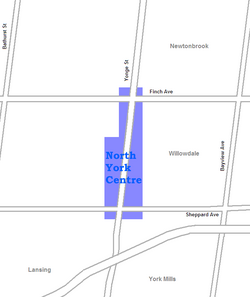
Yonge Street is a major arterial route in the Canadian province of Ontario connecting the shores of Lake Ontario in Toronto to Lake Simcoe, a gateway to the Upper Great Lakes. Ontario's first colonial administrator, John Graves Simcoe, named the street for his friend Sir George Yonge, an expert on ancient Roman roads.
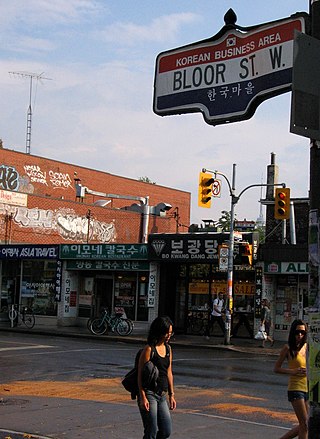
Koreatown is an ethnic enclave within Seaton Village, a neighbourhood of Toronto, Ontario, Canada. Located along Bloor Street between Christie and Bathurst Streets, the area is known for its Korean business and restaurants. The ethnic enclave developed during the 1970s, as the city experienced an influx of Korean immigrants settling in Toronto. Toronto has the largest single concentration of Koreans in Canada with 53,940 living in the city, according to the Canada 2016 Census.
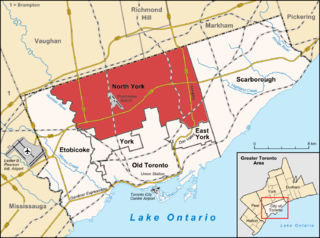
North York is a former township and city and is now one of the six administrative districts of Toronto, Ontario, Canada. It is located in the northern area of Toronto, centred around Yonge Street, north of Ontario Highway 401. It is bounded by York Region to the north at Steeles Avenue, on the west by the Humber River, on the east by Victoria Park Avenue. Its southern boundary corresponds to the northern boundaries of the former municipalities of Toronto: York, Old Toronto and East York. As of the 2016 Census, the district has a population of 644,685.

Line 4 Sheppard is the newest and shortest subway line of the Toronto subway system, operated by the Toronto Transit Commission (TTC). It opened on November 22, 2002, and has five stations along 5.5 kilometres (3.4 mi) of track, which is built without any open sections in the district of North York along Sheppard Avenue East between Yonge Street and Don Mills Road. All stations are wheelchair accessible and are decorated with unique public art.

Line 1 Yonge–University is a rapid transit line on the Toronto subway. It serves Toronto and the neighbouring city of Vaughan in Ontario, Canada. It is operated by the Toronto Transit Commission, has 38 stations and is 38.4 km (23.9 mi) in length, making it the longest line on the subway system. It opened as the "Yonge subway" in 1954 as Canada's first underground passenger rail line, and was extended multiple times between 1963 and 2017. Averaging over 670,000 riders per weekday, Line 1 is the busiest rapid transit line in Canada, and one of the busiest lines in North America.
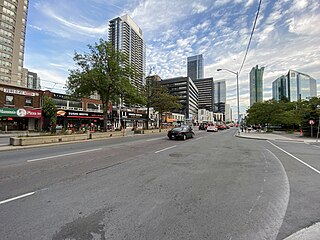
Willowdale is a neighbourhood in the city of Toronto, Ontario, Canada, located in the district of North York. It developed from three postal villages: Newtonbrook, Willowdale and Lansing.
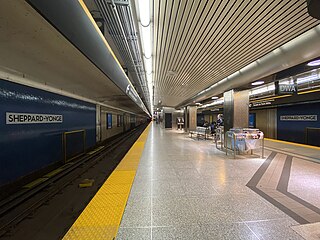
Sheppard–Yonge is an interchange station on Line 1 Yonge–University and Line 4 Sheppard of the Toronto subway. The station is located at the southern end of North York City Centre. It is the fourth-busiest station in the system, after Bloor–Yonge, St. George and Union, serving a combined total of approximately 134,076 people per day in 2019.

North York Centre is a subway station on Line 1 Yonge–University of the Toronto subway system. The station is located under Yonge Street, where it is intersected by Park Home Avenue and Empress Avenue. The station, the system's first and only infill station, opened in 1987 to serve North York City Centre, a high density business district in the Willowdale neighbourhood. Wi-Fi service is available at this station.

Finch is the northern terminus subway station of the eastern section of Line 1 Yonge–University in Toronto, Ontario, Canada. It is located under Yonge Street, north of Finch Avenue.

The North Yonge Railways was a radial railway line operated by the Toronto Transportation Commission from 1930 to 1948 between Glen Echo (Toronto) and Richmond Hill. The line was created by reopening the southern portion of the TTC's Lake Simcoe radial line that had closed in 1930.

North York Central Library is a Toronto Public Library branch located in North York City Centre, Toronto, Ontario, Canada. It is one of the two libraries in Toronto considered to be "Research and Reference Libraries", the other being the Toronto Reference Library in the city's downtown core. In contrast to the Toronto Reference Library, however, most of the items in the North York Central Library can be signed out.

Willowdale is a federal electoral district in Toronto, Ontario, Canada. It has been represented in the House of Commons of Canada since 1979. It is the riding with the biggest Korean community in Canada. As per the 2021 census, 9.9% of the population of Willowdale is Korean.

The North York Civic Centre is a municipal government building in Toronto, Ontario, Canada. It opened in 1979 as the city hall of the former city of North York. It is located in North York City Centre.

Mel Lastman Square is a public square at North York Civic Centre in Toronto, Ontario, Canada. It is named after then North York mayor Mel Lastman. It was officially opened on June 16, 1989, by Norman Jewison and Mel Lastman's granddaughter Brie Lastman. The architects were J. Michael Kirkland.
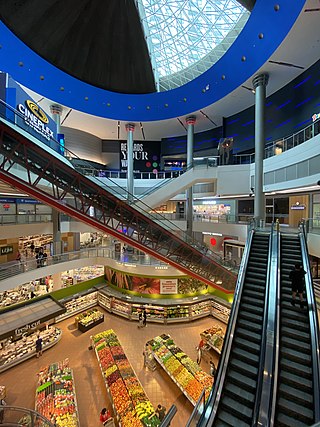
Empress Walk is a large Canadian condominium and retail complex in Toronto, Ontario, Canada. It is located at the intersection of Yonge Street and Empress Avenue in the North York Centre area of the North York district It was developed by Canadian-developers Menkes Developments Ltd. Phase 1 was completed in 1997 and Phase 2 was completed in 2000. It became an important retail complex in North York following its construction.

York University Heights, also known as Northwood Park, is a neighbourhood in Toronto, Ontario, Canada. It is one of Toronto's northernmost neighbourhoods, located along the northern boundary of Steeles Avenue in the former city of North York. The neighbourhood is so named because it contains the main campus of York University. This area is most popular with immigrants of Italian and Chinese descent who have established communities in the area. It is located between Sheppard Avenue and Steeles Avenue east of Black Creek.

Lansing is a neighbourhood in Toronto, Ontario, Canada. It originated as a minor settlement of a store, other services and a post office at the corner of Yonge Street and Sheppard Avenue and later got consolidated with Toronto as sprawling development took place. A larger area was designated as the postal village of Lansing. The City of Toronto labels it as Lansing-Westgate for neighbourhood planning purposes with the boundaries Yonge Street to the east, Highway 401 to the south, Bathurst Street to the west and Burnett Avenue to the north.
Network 2011 was a plan for transit expansion created in 1985 by the Toronto Transit Commission. It was centred on three proposed subway lines: the Downtown Relief Line, Eglinton West Line, and the Sheppard Line. Only a portion of the Sheppard Line was built. The Eglinton West and Downtown Relief Lines were cancelled; they were superseded by the Eglinton Crosstown light rail line and the Ontario Line respectively.

